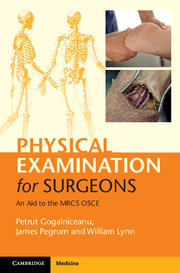Book contents
- Frontmatter
- Dedication
- Contents
- List of contributors
- Introduction
- Acknowledgments
- List of abbreviations
- Section 1 Principles of surgery
- Section 2 General surgery
- Section 3 Breast surgery
- Section 4 Pelvis and perineum
- Section 5 Orthopaedic surgery
- Section 6 Vascular surgery
- Section 7 Heart and thorax
- Section 8 Head and neck surgery
- Section 9 Neurosurgery
- Section 10 Plastic surgery
- 39 Examination of skin lesions and lumps
- 40 Examination of scars
- 41 Examination of flaps and grafts
- 42 Examination of burns
- 43 Examination of the hands
- Section 11 Surgical radiology
- Section 12 Airway, trauma and critical care
- Index
41 - Examination of flaps and grafts
from Section 10 - Plastic surgery
Published online by Cambridge University Press: 05 July 2015
- Frontmatter
- Dedication
- Contents
- List of contributors
- Introduction
- Acknowledgments
- List of abbreviations
- Section 1 Principles of surgery
- Section 2 General surgery
- Section 3 Breast surgery
- Section 4 Pelvis and perineum
- Section 5 Orthopaedic surgery
- Section 6 Vascular surgery
- Section 7 Heart and thorax
- Section 8 Head and neck surgery
- Section 9 Neurosurgery
- Section 10 Plastic surgery
- 39 Examination of skin lesions and lumps
- 40 Examination of scars
- 41 Examination of flaps and grafts
- 42 Examination of burns
- 43 Examination of the hands
- Section 11 Surgical radiology
- Section 12 Airway, trauma and critical care
- Index
Summary
Checklist
WIPER
Physiological parameters
General
• Note any scars, deformities or skin lesions. Offer to inspect the whole body.
Inspection
• Identify any flaps and grafts, and describe any scars present (see Chapter 40, Examination of scars).
• Comment on the location.
• Flap:
• site and size
• type of flap: local, regional or distant
• phase of healing: well-healed, immaturity of scar, adequacy of outcome
• check donor sites or exposure scars
• Graft:
• site, size and colour match of graft
• type of graft:
– pattern of scarring: split-thickness skin graft (STSG) or full-thickness skin graft (FTSG)
– cobblestone or crocodile skin appearance (derived from a meshed graft)
• healing: graft take as a percentage
• bed of flap: muscle flap/native muscle/fat
• Check common graft donor sites:
• upper thighs for STSG
• inner upper arms, supraclavicular fossa, retroauricular, groins for FTSG
Palpation
• Consistency: thickness, pliability, contour
• Vascular supply: colour, capillary refill
• Neurology: sensation
• Base:
• firm (recurrent disease or scarring)
• fluctuant (seroma or haematoma)
To complete the examination…
• Inspect for donor sites and any other scars/skin lesions.
• Offer to palpate regional lymphatic drainage sites if previous cancer excisions.
Examination notes
What is the system for inspecting flaps and grafts?
S-T-H-D:
Site
Type
Healing
Donor site
What is the difference between a flap and graft?
• A skin graft consists of skin tissue taken from one area of the body and transferred to another, being dependent on the recipient site for blood and nutrients.
• A flap consists of tissue taken from one area of the body and transferred to another, bringing with it its own source of blood and nutrients.
What are the different types of grafts?
Split-thickness skin graft (STSG)
• Split-thickness skin grafts consist of epidermis and a variable amount of dermis.
• STSGs are able to resurface larger areas than full-thickness grafts.
- Type
- Chapter
- Information
- Physical Examination for SurgeonsAn Aid to the MRCS OSCE, pp. 362 - 366Publisher: Cambridge University PressPrint publication year: 2015



